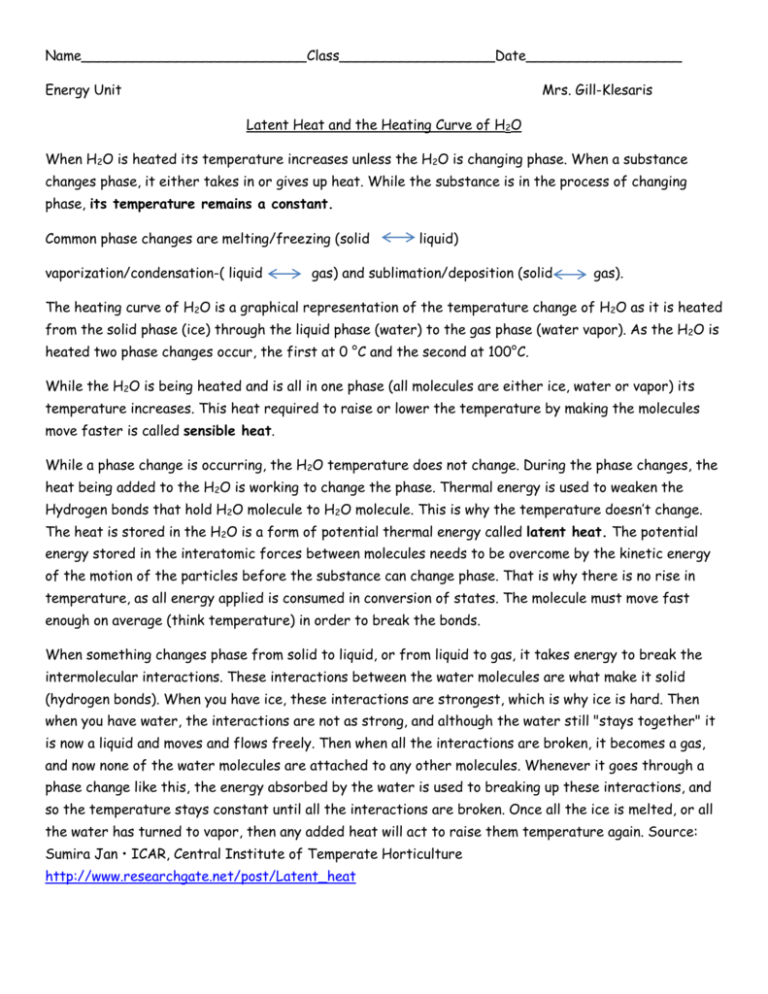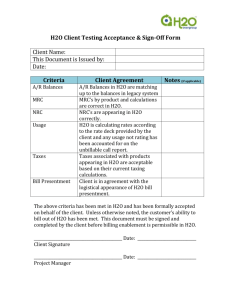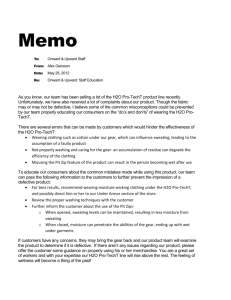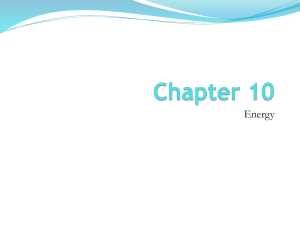Latent Heat and Heating curve of Water
advertisement

Name__________________________Class__________________Date__________________ Energy Unit Mrs. Gill-Klesaris Latent Heat and the Heating Curve of H2O When H2O is heated its temperature increases unless the H2O is changing phase. When a substance changes phase, it either takes in or gives up heat. While the substance is in the process of changing phase, its temperature remains a constant. Common phase changes are melting/freezing (solid vaporization/condensation-( liquid liquid) gas) and sublimation/deposition (solid gas). The heating curve of H2O is a graphical representation of the temperature change of H2O as it is heated from the solid phase (ice) through the liquid phase (water) to the gas phase (water vapor). As the H2O is heated two phase changes occur, the first at 0 °C and the second at 100°C. While the H2O is being heated and is all in one phase (all molecules are either ice, water or vapor) its temperature increases. This heat required to raise or lower the temperature by making the molecules move faster is called sensible heat. While a phase change is occurring, the H2O temperature does not change. During the phase changes, the heat being added to the H2O is working to change the phase. Thermal energy is used to weaken the Hydrogen bonds that hold H2O molecule to H2O molecule. This is why the temperature doesn’t change. The heat is stored in the H2O is a form of potential thermal energy called latent heat. The potential energy stored in the interatomic forces between molecules needs to be overcome by the kinetic energy of the motion of the particles before the substance can change phase. That is why there is no rise in temperature, as all energy applied is consumed in conversion of states. The molecule must move fast enough on average (think temperature) in order to break the bonds. When something changes phase from solid to liquid, or from liquid to gas, it takes energy to break the intermolecular interactions. These interactions between the water molecules are what make it solid (hydrogen bonds). When you have ice, these interactions are strongest, which is why ice is hard. Then when you have water, the interactions are not as strong, and although the water still "stays together" it is now a liquid and moves and flows freely. Then when all the interactions are broken, it becomes a gas, and now none of the water molecules are attached to any other molecules. Whenever it goes through a phase change like this, the energy absorbed by the water is used to breaking up these interactions, and so the temperature stays constant until all the interactions are broken. Once all the ice is melted, or all the water has turned to vapor, then any added heat will act to raise them temperature again. Source: Sumira Jan • ICAR, Central Institute of Temperate Horticulture http://www.researchgate.net/post/Latent_heat Part 1: After completing the introductory reading. Use the graph below (Heating Curve of H2O) and Temperature °C formulas below to answer questions 1-20. Latent Heat: Energy gained or released during a phase change using properties of water chart ESRT pg.1 P∆= m x LH Sensible Heat: Energy gained or released during the heating and cooling a specific state of matter. Using the Specific heat chart on p. 1 in the ESRT. Please base your answers to 1-20 on the heating curve of H2O above and on the following situation: Assume that the graph is based on a laboratory investigation in which a student started with 300g of ice at an initial temperature of -50°C. The student added heat to the ice at a constant rate for 25 minutes and recorded the temperature at one-minute intervals. 1. In which phase or phases is the H2O between points A and B? ____________________ During this time is it gaining SENSIBLE or LATENT HEAT? ___________________ 2. In which phase or phases is the H2O between points B and C? ____________________ During this time is it gaining SENSIBLE or LATENT HEAT? ___________________ 3. In which phase or phases is the H2O between points C and D? ____________________ During this time is it gaining SENSIBLE or LATENT HEAT? ______________________ 4. In which phase or phases is the H2O between points D and E? ____________________ During this time is it gaining SENSIBLE or LATENT HEAT? ______________________ 5. In which phase or phases is the H2O between points E and F? ____________________ During this time is it gaining SENSIBLE or LATENT HEAT? __________________ For questions 6-16 show all work below including the formula. Write final answers in the the boxes provided. 6. What is the rate of temperature change between points A and B? 7. What is the rate of temperature change between points B and C? 8. What is the rate of temperature change between points C and D? 9. What is the rate of temperature change between points D and E? 10. What is the rate of temperature change between points E and F? 11. How much heat energy in Joules is gained by the H2O between points A and B? 12. How much heat energy in Joules is gained by the H2O between points B and C? 13. How much heat energy in Joules is gained by the H2O between points C and D? 14. How much heat energy in Joules is gained by the H2O between points D and E? 15. How much heat energy in Joules is gained by the H2O between point E and F? 16. How much heat energy in Joules is gained by the H2O total between point A and F? 17. Between which lettered locations does the H2O gain the most energy? What is your evidence? _________________________________________________________________________ _________________________________________________________________________ _________________________________________________________________________ 18. During which phase change does H2O release the most latent heat to the atmosphere? What is your evidence? _________________________________________________________________________ _________________________________________________________________________ _______________________________________________________________________ 19. What is the most probable explanation for the constant temperature between points D and E on the graph? a) The added heat was radiated as fast as it was absorbed. b) The added heat was lost to the surroundings. c) The added heat changed water vapor to liquid water. d) The added heat changed liquid water to water vapor. 20. If equal masses of water in various phases are compared, which phase will contain the greatest amount of stored energy (latent heat)? ____________________________________ Part 2: Use the data below to construct a graph on the next page that shows the changes in temperature as 10 grams of water undergoes phase changes from solid to liquid and liquid to gas. Time (Minutes) 1 2 3 4 5 6 7 8 9 10 11 12 13 14 15 Temperature (°C) -9 -3 0 0 0 0 0 0 15 30 45 60 75 90 100 Time (minutes) 16 17 18 19 20 21 22 23 24 25 26 27 28 29 30 Temperature (°C) 100 100 100 100 100 100 100 100 100 100 105 118 123 128 135 Heating Curve of Water -10 0 A) On your graph label the following: Solid Ice, Liquid Water, Water Vapor, Melting, Vaporization B) At what minute did the ice begin to melt?_______________________ C) How many minutes did the ice take to melt?_________________ D) At what minute is the ice entirely melted?________________ E) At what minute did the water begin to boil?_______________ F) How many minutes did the water take to boil?___________________ G) During what time period was the sample in the solid phase?___________________ H) During what time period was the sample in the liquid phase?___________________ I) During what time period was the sample in the gas phase?___________________ J) How much energy is gained by the water as it changes from solid to liquid______________ K) What happened to the temperature of the water between the time the ice melted and the water boiled?________________________________ Part 3: Conclusion Questions 1. Describe latent heat as it relates to Potential Energy. _________________________________________________________________________ _________________________________________________________________________ _________________________________________________________________________ 2. Describe sensible heat as it relates to Kinetic Energy. _________________________________________________________________________ _________________________________________________________________________ _________________________________________________________________________ 3. https://www.khanacademy.org/science/health-and-medicine/human-anatomy-andphysiology/integumentary-system-introduction/v/lebron-asks-why-does-sweating-cool-you-down Go to this website and then explain why sweating cools you down? _________________________________________________________________________ _________________________________________________________________________ _________________________________________________________________________ 4. Conclusion: How do land and water differ in their abilities to absorb and radiate heat energy? Why does temperature remain the same as water undergoes a phase change? Include and describe the significance of key word: condensation, vaporization, freezing, melting, states of matter, specific heat, phase change, energy transformation, latent heat and sensible heat. _________________________________________________________________________ _________________________________________________________________________ _________________________________________________________________________ _________________________________________________________________________ _________________________________________________________________________ _________________________________________________________________________ _________________________________________________________________________ _________________________________________________________________________ _________________________________________________________________________ _________________________________________________________________________ _________________________________________________________________________ _________________________________________________________________________ _________________________________________________________________________ _________________________________________________________________________ _________________________________________________________________________







